Publication
Article
Psychiatric Times
Dementia: A Focused Review
Author(s):
This article reviews the differences between dementia types and future directions.
You must keep your own records of this activity. Copy this information and include it in your continuing education file for reporting purposes.
CME LLC is accredited by the Accreditation Council for Continuing Medical Education to provide continuing medical education for physicians.
CME LLC designates this educational activity for a maximum of 1.5 AMA PRA Category 1 Credits™. Physicians should only claim credit commensurate with the extent of their participation in the activity.
CME LLC is approved by the California Board of Registered Nursing, Provider No. CEP12748, and designates this educational activity for 1.5 contact hours for nurses.
The American Nurses Credentialing Center (ANCC) accepts AMA PRA Category 1 Credits™ toward recertification requirements.
The American Academy of Physician Assistants (AAPA) accepts AMA PRA Category 1 Credits™ from organizations accredited by the ACCME.
Educational Objectives
After reading this article, you will be familiar with:
• The differences between the dementias and their causes
• Differential diagnosis of the dementias
• Treatment strategies for the dementias
• Future direction of clinical studies
Who will benefit from reading this article?
Psychiatrists, child and adolescent psychiatrists, psychologists, primary care physicians, nurse practitioners, and other health care professionals. To determine whether this article meets the continuing education requirements of your specialty, please contact your state licensing and certification boards.
When discussing the concept of cognitive impairment, many terms are used, including dementia, amnestic disorder, cognitive impairment not dementia (CIND), cognitive impairment associated with normal aging, mild cognitive impairment, vascular cognitive impairment, and vascular cognitive impairment not dementia (VCIND). Although definitions of such terms are clinically important, there is significant uncertainty about associating a given cognitive syndrome with specific neuropathology.1
Definitions
DSM-IV-TR defines dementia as the development of multiple cognitive deficits that include memory impairment and at least 1 of the following cognitive disturbances: aphasia, apraxia, agnosia, or a disturbance in executive functioning. The cognitive deficits must be sufficiently severe to cause impairment in occupational or social functioning and must represent a decline from a previously higher level of functioning. Amnestic disorder includes the inability to learn new information or to recall previously learned information, and deficits can consist of faulty encoding, faulty consolidation, faulty retrieval, or confabulation. The ability to immediately repeat a sequential string of information, such as a digit span, is generally not impaired in amnestic disorder.
CIND is a clinical syndrome that consists of a measurable or evident decline in memory or other cognitive abilities with little impact on day-to-day functioning. However, criteria are not met for dementia as defined by DSM-IV-TR. Cognitive impairment associated with normal aging includes memory retrieval deficiencies, decreased psychomotor speed, decreased reaction time, decreased performance on executive tasks, and decreased visuospatial skills. Although some cognitive impairment is present with normal aging, increasing age does not automatically mean losing all cognitive abilities.
Mild cognitive impairment can be divided into amnestic and nonamnestic subtypes: each subtype has deficits in a single domain or in multiple domains. Key features of the amnestic subtype of mild cognitive impairment include a subjective memory complaint also noticed by an informant, objective deficits in cognition for age, normal functional activities, preserved general cognition, and the absence of dementia. Although Alzheimer dementia most commonly develops in patients with mild cognitive impairment, other types of non-Alzheimer dementia, such as Lewy body dementia, can also occur.2
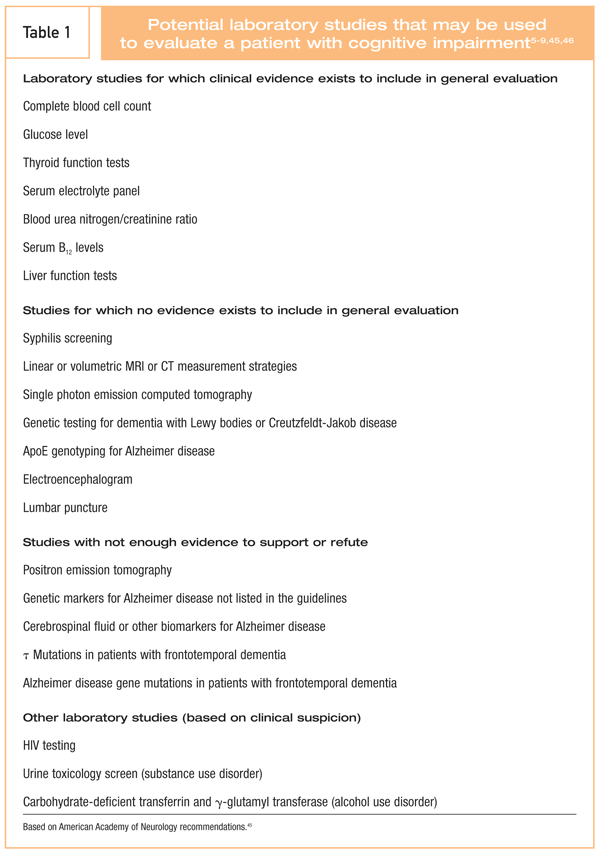
Vascular cognitive impairment is a heterogeneous group of conditions in which vascular factors are associated with or are the cause of cognitive deficits of any severity. Vascular cognitive impairment is likely the prodrome of vascular dementia and it generally affects executive functions.1
VCIND is a clinical syndrome of cognitive impairment of a presumed vascular cause, but it is not severe enough to fulfill the criteria for dementia.3,4
Assessment of patients with cognitive impairment
In the evaluation of cognitive impairment, there is no routine workup. The workup must be individualized for each patient. Assessment begins with a thorough medical, neurological, and psychiatric evaluation, followed by collateral information from caregivers. Current medications (eg, benzodiazepines, anticholinergics, β-blockers, corticosteroids, and opioids) may be contributing to cognitive impairment.5-9 Neuropsychological testing can help establish the baseline level of cognitive functioning, monitor changes in cognitive functioning over time, differentiate various types of dementia, identify cognitive strengths and weaknesses, guide therapeutic interventions, and de-termine functional capacity. Laboratory studies (Table 1) should be viewed as complementary to––not a substitute for––a complete evaluation.
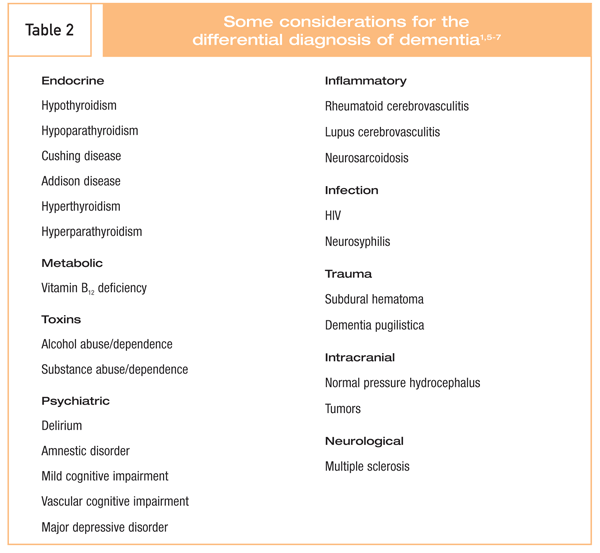
Differential diagnosis for dementia
Before making a diagnosis of a specific disease process, a proactive and detailed investigation for any possible cause is warranted. Table 2 lists some considerations for the differential diagnosis of dementia.
Delirium may be confused with dementia, although both delirium and dementia can coexist. In delirium, the disturbance of consciousness occurs over a short period (hours to days) and fluctuates over the course of a day. In dementia, the disturbance is more gradual/insidious and generally does not fluctuate, as in delirium. In the early and middle stages of dementia, the patient maintains alertness and attention, but in delirium, attention to the environment is decreased and the level of arousal is altered. Although attention can be impaired in the late stages of dementia, a fluctuating level of consciousness may indicate a superimposed delirium.6Table 3lists some considerations for the differential diagnosis of delirium.
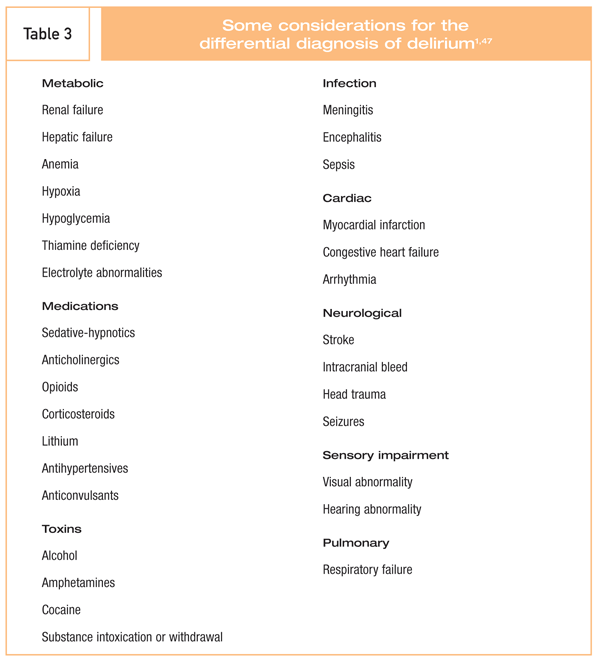
Major depression can lead to cognitive impairment and must be distinguished from dementia, although both major depression and dementia can coexist. Aphasia, apraxia, and anomia are not features of depression-induced cognitive impairment. Initial symptoms include dysphoria and anhedonia, followed by cognitive impairment. In major depression, “I don’t know” is a common answer to questions about cognition.5 Neuropsychological features include impaired performance on tasks that involve effortful processing, memory improvement with cueing, and tendency to abandon tasks because of poor motivation. Elderly depressed patients who have residual cognitive impairment even after improvement of depression usually have an early stage of dementia, and cognitive impairment is exaggerated when depression is superimposed.
Normal pressure hydrocephalus includes a classic triad of dementia, gait disturbance, and urinary incontinence. The apraxic gait disturbance is often the initial presentation, and patients appear to be “glued” to the floor.10 Patients may present for a psychiatric evaluation with complaints of memory loss, apathy, or depression. In many instances, the cause is unknown. Risk factors include a history of brain hemorrhage, brain surgery, head injury, or meningitis. Neuropsychological features include slowed information processing and difficulty with memory retrieval. Neurosurgical treatment with a shunt is indicated for some patients. However, this treatment is controversial, and serious complications can occur-such as infection, intracerebral hemorrhage, or blockage of the shunt.11-13
Dementia can also be caused by endocrine disorders. If hypothyroidism is left untreated, for example, dementia can appear, and aggressive thyroid replacement may not return a patient to his or her previous level of cognitive functioning. The dementia with untreated hypothyroidism is also accompanied by irritability, paranoia, and depression. Cushing disease and Addison disease may lead to dementia. Hypoparathyroidism is the most common cause of basal ganglia calcification with dementia. Hyperthyroidism and hyperparathyroidism may also lead to dementia.
Untreated vitamin B12 deficiency can lead to dementia in the absence of anemia or megaloblastosis. Vitamin B12 replacement may improve cognition, but dementia may still continue. High-dose vitamin B supplements do not slow cognitive decline in patients with mild to moderate Alzheimer dementia.14
Head trauma may cause dementia from diffuse axonal injury secondary to shearing forces, focal contusions, hemorrhages, lacerations, and hypoxic ischemia. Symptoms include anterograde and retrograde amnesia, deficiencies in encoding and retrieval of new information, disorganized thinking, poor concentration, and fluent aphasia.
Dementia pugilistica, a syndrome caused by repeated head trauma in boxers, leads to a clinical picture of dementia and ataxia. A study of retired National Football League players found that the incidence of diseases of memory (dementia, Alzheimer disease [AD], or other memory-related disease) was higher in retired players than in the general population.15 However, cognitive tests and neurological examinations were not completed, which significantly limits interpretation of these results.
A chronic subdural hematoma may be caused by mild head trauma in elderly patients and can lead to a clinical picture of dementia. Associated symptoms may include headache, slowed thinking, hemiparesis, change in personality, seizures, and aphasia. Any patient with a subdural hematoma must receive immediate neurosurgical evaluation. Surgical drainage may or may not be required, but an acute bleed can occur, and the pa-tient may have further neurological deterioration.16
Infectious processes can cause a clinical picture of dementia. Neurosyphilis can cause dementia even after 20 years from the time of infection. General paresis, a subtype of neurosyphilis, may present as a progressive dementia, changes in speech, irritability, grandiose delusions, and hallucinations.5,17 The rapid plasma reagin test has a high false-positive rate and results may be negative in late syphilis. A fluorescent treponemal antibody absorption test may be a better tool for diagnosis.
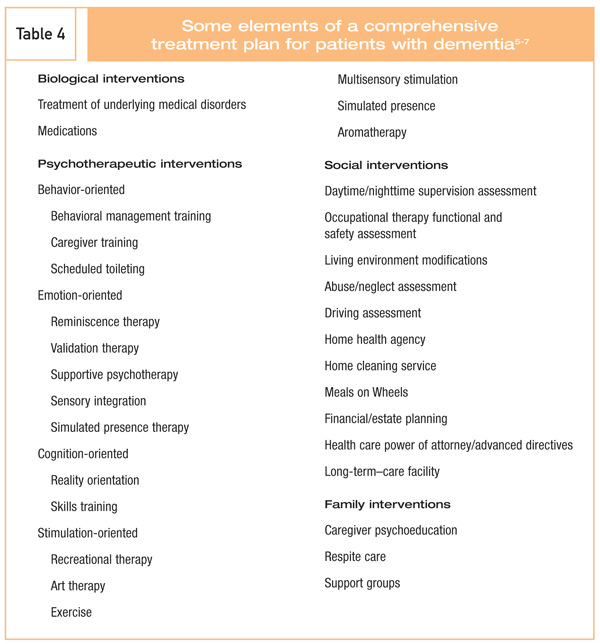
HIV-associated dementia affects subcortical structures while sparing the cortex. Forgetfulness, poor concentration, and slowed thinking are early symptoms. Apathy and social withdrawal may arise, and psychosis occurs occasionally. Patients with AIDS may have infections, CNS malignancies, or systemic illness that may lead to cognitive impairment.
Toxins can cause a clinical picture of dementia. Long-term alcohol use can lead to alcoholic dementia, which includes anterograde and retrograde amnesia. Alcoholic dementia is mild and slowly progressive; it is associated with impairments on initial letter fluency, fine motor control, and free recall.
Comprehensive treatment planning
Patients with dementia need a comprehensive treatment plan, including biological, psychotherapeutic, social, and family interventions (Table 4).
Biological interventions include treatment of any underlying medical disorders and the appropriate use of medications for target symptoms. Psychotherapeutic interventions can be generally divided into 4 categories:
• Behavior-oriented
• Emotion-oriented
• Cognition-oriented
• Stimulation-oriented
Although many psychotherapeutic interventions are commonly used in clinical practice, only a few of these interventions have undergone double-blind randomized evaluation.7
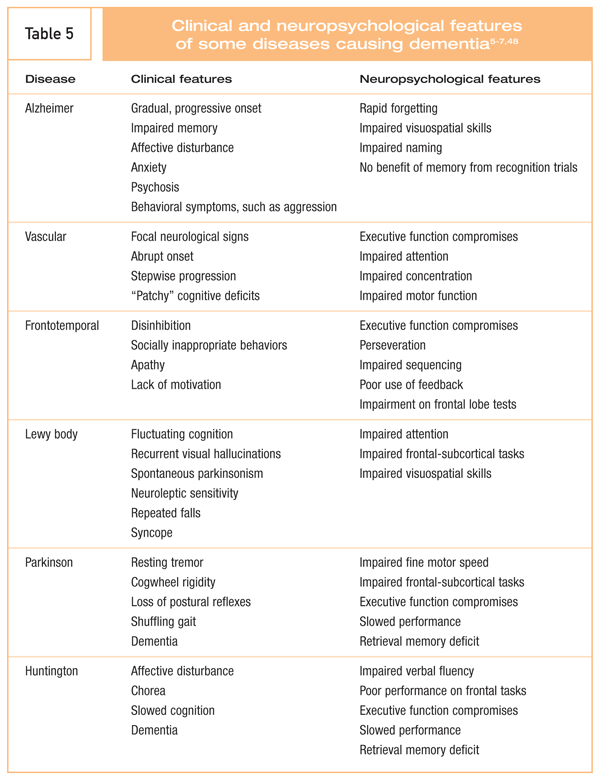
Social interventions include assessments of the patient’s living environment, his ability to drive, risk level for abuse and/or neglect, availability of daytime/nighttime supervision, and occupational therapy to ensure home safety. Services such as a home health aide, a house cleaner, and Meals on Wheels may be needed to assist with basic activities of daily living. A discussion about financial/estate planning, health care power of attorney/advanced care directives, and long-term–care facilities may be needed as the dementia progresses.
Family interventions to help prevent caregiver burnout include supporting family caregivers with psychoeducation, respite care, and referral to local support groups through national associations. A list of print and Internet resources that may be useful for those who care for patients with dementia is posted on www.psychiatrictimes.com in the online version of this article.
Table 5 highlights key clinical and neuropsychological features of certain diseases that may cause dementia. The following discussion focuses primarily on cognitive aspects.
Alzheimer disease
The most common cause of dementia in North America and Europe is AD; approximately 4 million persons in the United States have AD.18 Risk factors include increasing age, traumatic brain injury, reduced brain reserve capacity, limited educational/occupational achievement, cerebrovascular disease, hyperlipidemia, hypertension, athero-sclerosis, coronary heart disease, atrial fibrillation, smoking, obesity, and diabetes.
Genetic predisposition is another major risk factor for AD, and most cases of AD are polygenic, although no genetic etiologies can be identified in many AD cases.19 The e4 allele of apolipoprotein E is associated with an increased risk of late-onset AD in both familial and sporadic cases; however, carrying 1 or 2 apoe4 alleles does not necessarily translate into the development of AD. Causative mutations in chromosome 21 (amyloid precursor protein gene), chromosome 14 (presenilin 1 gene), and chromosome 1 (presenilin 2 gene) have been identified for early-onset AD, although the proportion of early-onset AD cases caused by these mutations is debatable. Many other genes and chromosomes are under investigation.18,19 AD is a heterogeneous disorder with many etiologies that involve different interactions between various genetic and environmental risk factors.3
Clinical features include an impaired ability to learn new information or to recall previously learned information, with aphasia, apraxia, agnosia, or disturbance in executive functioning. Neuropathological hallmarks of AD include neuritic plaques, neurofibrillary tangles, and loss of neurons in the cholinergic, serotonergic, and dopaminergic neurotransmitter systems.
Management of associated vascular risk factors (such as elevated blood pressure and diabetes) and weight loss, exercise, and a healthy diet are important medical interventions for AD. Nonpharmacological interventions include psychotherapeutic, social, and family interventions (Table 4). Pharmacological interventions for AD approved by the FDA include cholinesterase inhibitors (donepezil, galantamine, rivastigmine, tacrine) and memantine.7 A discussion on evaluation, management, and medication use for associated neuropsychiatric symptoms can be found elsewhere.20,21
Vascular dementia
Vascular dementia accounts for 4% to 22% of all dementias in Western society and up to 50% of all dementias in Japan.22 Risk factors include increasing age, hypertension, diabetes mellitus, obesity, smoking, hyperlipidemia, coronary artery disease, and arrhythmias.
Several criteria have been proposed to diagnose vascular dementia, although none have been definitively validated and the clinical utility of these criteria is questionable.23,24 The National Institute of Neurological Disorders and Stroke–Association Internationale pour la Recherche et l’Enseignement en Neurosciences criteria include neurological signs, levels of certainty, and a list of potential locations for vascular lesions.25 Because vascular dementia is heterogeneous, there are no widely accepted neuropathological markers for vascular dementia and its subtypes.
Clinical features of vascular dementia, as defined by DSM-IV-TR, include focal neurological signs and symptoms or laboratory evidence of cerebrovascular disease that is determined to be etiologically related to the disturbance. Clinical features may be abrupt in onset and show a stepwise progression, although presentation of features may be variable.
Treatment of risk factors can help decrease the risk of vascular dementia. Although limited evidence exists for cholinesterase inhibitors (such as donepezil and rivastigmine), there are still no FDA-approved medications for the treatment of vascular dementia.
Frontotemporal dementia
Frontotemporal dementia accounts for 20% to 50% of cases of dementia that occur before age 65. It is the second most common subtype of dementia in patients who have dementia onset before age 65.1,26 Postmortem investigations have shown that the relative frequency of frontotemporal dementia is 3% to 10%.27 Risk factors include a history of head trauma, family history of frontotemporal dementia, and (possibly) thyroid disease. Amyotrophic lateral sclerosis (ALS) can be comorbid with frontotemporal dementia: ALS symptoms may present later in the course of frontotemporal dementia. Alternatively, frontotemporal dementia may present as the ALS progresses.3
Positron emission tomography (PET) has been approved by Medicare to differentiate between AD and frontotemporal dementia, although many private insurers do not pay for PET scans for this purpose.
Frontotemporal lobar degeneration is the generic term for the spectrum of frontotemporal dementia-related pathologies, which are generally divided into 3 groups: frontal-variant or behavioral-variant; progressive nonfluent aphasia; and semantic dementia. The core diagnostic features in the consensus clinical diagnostic criteria for frontotemporal dementia are:
• Insidious onset and gradual progression
• Early decline in social interpersonal conduct
• Early impairment in regulation of personal conduct
• Early emotional blunting, and early loss of insight
Neuropathologically, the report of the Working Group on Frontotemporal Dementia and Pick’s Disease recommended 5 categories for the classification of frontotemporal dementias. These were based on the presence or absence of Ï-positive and ubiquitin-positive inclusions, the predominance of microtubule-binding repeats in insoluble t, and the presence of motor neuron disease-type inclusions.28
Various mood abnormalities, such as major depression, affective reactivity and lability, and profound apathy, can be seen in patients with frontotemporal dementia. In older patients who present with mood abnormalities, frontotemporal dementia should be included in the differential diagnosis.29
Nonpharmacological interventions include caregiver support; attending to functional issues, such as driving and home safety; and behavioral management strategies. Pharmacological interventions include SSRIs for such neuropsychiatric symptoms as disinhibition-impulsivity, depression, and repetitive behaviors. Atypical antipsychotics may be needed to control aggressive behaviors. Acetylcholinesterase inhibitors could ex-acerbate disinhibition-impulsivity and repetitive behaviors, and the role of memantine is being investigated.26
Lewy body disorders
The members of the Dementia With Lewy Bodies/Parkinson’s Disease With Dementia working group have endorsed the term “Lewy body disorders” as the umbrella term for Parkinson disease, Parkinson disease with dementia, and dementia with Lewy bodies.30 All of these disorders share a mechanism of neurodegeneration involving a-synuclein metabolism.
A “Lewy body” is an intracytoplasmic neuronal inclusion that contains a-synuclein; a “Lewy neurite” is an inclusion confined to neuronal processes (axons and dendrites) that contains a-synuclein. An important clinical consideration is that many patients with Lewy body disorders have coexisting pathologies, such as Alzheimer and vascular dementia.
Dementia with Lewy bodies. Neuropathological data suggest that approximately 15% to 30% of all dementias are associated with Lewy bodies.31 Dementia with Lewy bodies is thought to be the second most common subtype of dementia. Epidemiological clinical studies show the prevalence of dementia with Lewy bodies to be as high as 5% in the general population and that it is the cause of up to 30.5% of all dementia cases.31
The Dementia With Lewy Bodies Consortium revised dementia with Lewy bodies criteria in its third report. The central feature is dementia, and core features are fluctuating cognition with pronounced variations in attention and alertness, recurrent visual hallucinations that are typically well formed and detailed, and spontaneous features of parkinsonism.32 Neuropathology demonstrates a wide spectrum of Lewy bodies with a broad distribution from brain stem to cortex and concurrent AD pathology in many cases. Cholinergic loss is greater in dementia with Lewy bodies than in AD.
Nonpharmacological interventions for patients with other types of dementia can also be helpful-such as improving sensory impairments, environmental structuring, and caregiver education.
Pharmacological treatment with cholinesterase inhibitors is the current strategy for cognitive impairment associated with dementia with Lewy bodies. The evidence for memantine is mixed.33 Patients with dementia with Lewy bodies are sensitive to antipsychotics; if antipsychotics are necessary, consider prescribing those agents least likely to cause extrapyramidal adverse effects. Tricyclic antidepressants, low-potency neuroleptics, antiparkinsonian anticholinergic drugs, and antispasmodics for the bladder or GI tract should be avoided if possible, because of orthostatic hypotension and worsening of cognition and psychotic symptoms.34
Parkinson disease and Parkinson disease with dementia. Dementia has been reported in about 20% to 44% of patients with Parkinson disease, although the range is 10% to 90%.35 Risk factors for dementia include early executive impairment, lower baseline mini-mental state examination scores, older age, possibly older age at onset of Parkinson disease, more severe disease, hallucinations, depression, and dementia in other family members.
The cognitive impairment in classic Parkinson disease is called dysexecutive syndrome, which includes psychomotor slowing and executive, attention, and visuospatial impairments. Memory impairment involves poor retrieval, and dementia is usually seen several years after the onset of motor symptoms. The Movement Disorder Study Task Force has proposed clinical diagnostic criteria for Parkinson disease dementia.36
Histopathological hallmarks are Lewy bodies and Lewy neurites. Lewy pathology begins at the brain stem, ascends to the substantia nigra, and finally ascends to the cerebral cortex, where Lewy pathology is associated with significant cognitive impairment. Dopaminergic, serotonergic, noradrenergic, and cholinergic deficits are associated with cognitive impairment.
Nonpharmacological interventions include educating caregivers about disease progression and about community resources. Cholinesterase inhibitors (donepezil, rivastigmine, galantamine, tacrine) may be beneficial in Parkinson disease with dementia.36,37 Rivastigmine is FDA-approved for Parkinson disease with dementia.38 The Quality Standards Subcommittee of the American Academy of Neurology has determined that improvement with cholinesterase inhibitors is modest and that adverse motor effects may occur.39
Huntington disease dementia
A trinucleotide repeat in the gene encoding for the huntingtin protein causes Huntington disease. The prevalence of Huntington disease is approximately 7 to 10 cases per 100,000 in white populations and is lower in mixed white, black, and Asian populations.40
In the early stages, cognitive impairments in attention, concentration, visuospatial ability, emotional processing, and memory become noticeable. In later stages, cognitive impairments in planning, problem solving, cognitive flexibility, and freedom from distractibility become evident. Cognitive impairments worsen to dementia, which is characterized by slow information processing, decreased motivation, depression, apathy, and personality changes.
Language is relatively spared. Psychosis and affective disturbances, including depression, suicide, and mania, develop in many patients. In the early stages, structural changes are relatively specific and primarily affect the caudate and putamen. Psychomotor, executive, visuospatial, and memory deteriorations appear to develop from basal ganglia pathology, which disturbs normal cognitive processes mediated by frontostriatal circuits. Resting-state and neurocognitive-activation functional imaging studies suggest that striatal and cortical dysfunction contributes to cognitive status.41
Treatments must be targeted to the stage of the disease. Nonpharmacological treatments for cognitive impairment include the use of schedules, “to do” lists, routines, and cues to help memory retrieval. Symptomatic treatment is the foundation of pharmacological management. However, a review of 22 trials that comprised 1254 patients who had Huntington disease found that no intervention produced a robust conclusive symptomatic effect.42 A review of another 8 trials involving 1366 patients found that no intervention modified disease progression.43 Depressive symptoms may respond to SSRIs, mirtazapine, or venlafaxine, although further data are needed to determine efficacy and safety.44
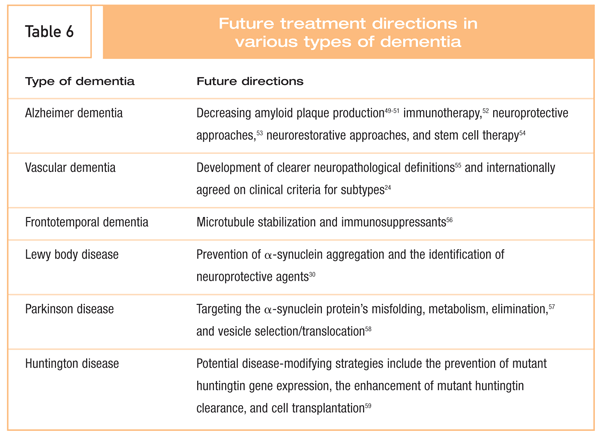
Conclusion
Newer treatment strategies and clearer descriptions of disease processes that cause dementia are two of the goals of current research (Table 6).
The concept of cognitive impairment entails many different terms, such as dementia, amnestic disorder, CIND, cognitive changes associated with normal aging, mild cognitive impairment, vascular cognitive impairment, and VCIND. The workup must be individualized to each patient’s unique presentation. A proactive and detailed investigation for any possible etiology is warranted. Management of any patient with dementia must be within the context of a comprehensive treatment plan.
References:
References
1. Lyketsos CG. Dementia and milder cognitive syndromes. In: Blazer DG, Steffens DC, eds. The American Psychiatric Publishing Textbook of Geriatric Psychiatry. 4th ed. Washington, DC: American Psychiatric Publishing; 2009:chap 13.
2. Petersen RC. Mild cognitive impairment as a diagnostic entity. J Intern Med. 2004;256:183-194.
3. Panza F, Frisardi V, Capurso C, et al. Possible predictors of vascular cognitive impairment–no dementia. J Am Geriatr Soc. 2009;57:943-944.
4. Stephan BC, Matthews FE, Khaw KT, et al. Beyond mild cognitive impairment: vascular cognitive impairment, no dementia (VCIND). Alzheimers Res Ther. 2009;1:4.
5. Sadavoy J, Jarvik LF, Grossberg GT, Meyers BS, eds. Comprehensive Textbook of Geriatric Psychiatry. 3rd ed. New York: WW Norton; 2004.
6. Blazer DG, Steffens DC, Busse EW, eds. Essentials of Geriatric Psychiatry. Washington, DC: American Psychiatric Publishing; 2007.
7. American Psychiatric Association, Work Group on Alzheimer’s Disease and Other Dementias. Practice Guideline for the Treatment of Patients With Alzheimer’s Disease and Other Dementias. 2nd ed. Washington, DC: American Psychiatric Association; 2007. http://www.psychiatryonline.com/pracGuide/loadGuidelinePdf.aspx?file=AlzPG101007. Accessed December 25, 2009.
8. Coluccia D, Wolf OT, Kollias S, et al. Glucocorticoid therapy-induced memory deficits: acute versus chronic effects. J Neurosci. 2008;28:3474-3478.
9. Vella-Brincat J, Macleod AD. Adverse effects of opioids on the central nervous systems of palliative care patients. J Pain Palliat Care Pharmacother. 2007;21:15-25.
10. Simon RP, Greenberg DA, Aminoff MJ. Disorders of cognitive function. In: Clinical Neurology. 7th ed. New York: McGraw-Hill; 2009:chap 1.
11. Finney GR. Normal pressure hydrocephalus. Int Rev Neurobiol. 2009;84:263-281.
12. Factora R, Luciano M. When to consider normal pressure hydrocephalus in the patient with gait disturbance. Geriatrics. 2008;63:32-37.
13. Graff-Radford NR. Normal pressure hydrocephalus. Neurol Clin. 2007;25:809-832, vii-viii.
14. Aisen PS, Schneider LS, Sano M, et al; Alzheimer Disease Cooperative Study. High-dose B vitamin supplementation and cognitive decline in Alzheimer disease: a randomized controlled trial. JAMA. 2008;300:1774-1783.
15. Weir DR, Jackson JS, Sonnega A. National Football League Player Care Foundation: Study of Retired NFL Players. Institute for Social Research, University of Michigan; 2009. http://umich.edu/news/Releases/2009/Sep09/FinalReport.pdf. Accessed December 25, 2009.
16.Stone CK, Humphries RL. Head injuries. In: CURRENT Diagnosis & Treatment: Emergency Medicine. 6th ed. New York: McGraw-Hill; 2008:chap 20.
17. Simon RP. Current diagnosis and treatment of sexually transmitted diseases. In: Klausner JD, Hook EW, eds. Neurosyphilis. New York: McGraw-Hill; 2007:chap 20.
18. Bird TD. Genetic aspects of Alzheimer disease. Genet Med. 2008;10:231-239.
19. Sweet RA, Wilkosz PA. Genetics. In: Blazer DG, Steffens DC, eds. The American Psychiatric Publishing Textbook of Geriatric Psychiatry. 4th ed. Washington, DC: American Psychiatric Publishing; 2009:chap 6.
20. Kalapatapu RK, Neugroschl JA. Update on neuropsychiatric symptoms of dementia: evaluation and management. Geriatrics. 2009;64:20-26.
21. Kalapatapu RK, Schimming C. Update on neuropsychiatric symptoms of dementia: antipsychotic use. Geriatrics. 2009;64:10-18.
22. Aggarwal NT, Decarli C. Vascular dementia: emerging trends. Semin Neurol. 2007;27:66-77.
23. Wetterling T, Kanitz RD, Borgis KJ. Comparison of different diagnostic criteria for vascular dementia (ADDTC, DSM-IV, ICD-10, NINDS-AIREN). Stroke. 1996;27:30-36.
24. Wiederkehr S, Simard M, Fortin C, van Reekum R. Comparability of the clinical diagnostic criteria for vascular dementia: a critical review. Part I. J Neuropsychiatry Clin Neurosci. 2008;20:150-161.
25. Román GC, Tatemichi TK, Erkinjuntti T, et al. Vascular dementia: diagnostic criteria for research studies. Report of the NINDS-AIREN International Workshop. Neurology. 1993;43:250-260.
26. Mendez MF, Lauterbach EC, Sampson SM. An evidence-based review of the psychopathology of frontotemporal dementia: a report of the ANPA Committee on Research. J Neuropsychiatry Clin Neurosci. 2008;20:130-149.
27. Weder ND, Aziz R, Wilkins K, Tampi RR. Frontotemporal dementias: a review. Ann Gen Psychiatry. 2007;6:15.
28. McKhann GM, Albert MS, Grossman M, et al; Work Group on Frontotemporal Dementia and Pick’s Disease. Clinical and pathological diagnosis of frontotemporal dementia: report of the Work Group on Frontotemporal Dementia and Pick’s Disease. Arch Neurol. 2001;58:1803-1809.
29. Blass DM, Rabins PV. Depression in frontotemporal dementia. Psychosomatics. 2009;50:239-247.
30. Lippa CF, Duda JE, Grossman M, et al; DLB/PDD Working Group. DLB and PDD boundary issues: diagnosis, treatment, molecular pathology, and biomarkers. Neurology. 2007;68:812-819.
31. Dodel R, Csoti I, Ebersbach G, et al. Lewy body dementia and Parkinson’s disease with dementia. J Neurol. 2008;255(suppl 5):39-47.
32. McKeith IG, Dickson DW, Lowe J, et al; Consortium on DLB. Diagnosis and management of dementia with Lewy bodies: third report of the DLB Consortium [published correction appears in Neurology. 2005;65:1992]. Neurology. 2005;65:1863-1872.
33. Burn DJ. Cortical Lewy body disease and Parkinson’s disease dementia. Curr Opin Neurol. 2006;19:572-579.
34. Hanson JC, Lippa CF. Lewy body dementia. Int Rev Neurobiol. 2009;84:215-228.
35. Truong DD, Bhidayasiri R, Wolters E. Management of non-motor symptoms in advanced Parkinson disease. J Neurol Sci. 2008;266:216-228.
36. Emre M, Aarsland D, Brown R, et al. Clinical diagnostic criteria for dementia associated with Parkinson’s disease. Mov Disord. 2007;22:1689-1707; quiz 1837.
37. Park A, Stacy M. Non-motor symptoms in Parkinson’s disease. J Neurol. 2009;256(suppl 3):293-298.
38. Weintraub D, Comella CL, Horn S. Parkinson’s disease-part 3: neuropsychiatric symptoms. Am J Manag Care. 2008;14(2 suppl):S59-S69.
39. Miyasaki JM, Shannon K, Voon V, et al; Quality Standards Subcommittee of the American Academy of Neurology. Practice parameter: evaluation and treatment of depression, psychosis, and dementia in Parkinson disease (an evidence-based review): report of the Quality Standards Subcommittee of the American Academy of Neurology. Neurology. 2006;66:996-1002.
40. Walker FO. Huntington’s disease. Semin Neurol. 2007;27:143-150.
41. Montoya A, Price BH, Menear M, Lepage M. Brain imaging and cognitive dysfunctions in Huntington’s disease. J Psychiatry Neurosci. 2006;31:21-29.
42. Mestre T, Ferreira J, Coelho MM, et al. Therapeutic interventions for symptomatic treatment in Huntington’s disease. Cochrane Database Syst Rev. 2009;(3):CD006456.
43. Mestre T, Ferreira J, Coelho MM, et al. Therapeutic interventions for disease progression in Huntington’s disease. Cochrane Database Syst Rev. 2009;(3):CD006455.
44. Cardoso F. Huntington disease and other choreas. Neurol Clin. 2009;27:719-736, vi.
45. American Academy of Neurology Guideline Summary for Clinicians: Detection, Diagnosis, and Management of Dementia. http://www.aan.com/professionals/practice/pdfs/dementia_guideline.pdf. Accessed December 25, 2009.
46. Kalapatapu RK, Chambers R. Novel objective biomarkers of alcohol use: potential diagnostic and treatment management tools in dual diagnosis care. J Dual Diagn. 2009;5:57-82.
47. American Psychiatric Association, Work Group on Delirium. Practice Guideline for the Treatment of Patients With Delirium. Washington, DC: American Psychiatric Association; 1999. http://www.psychiatryonline.com/pracGuide/loadGuidelinePdf.aspx?file=Delirium_Inactivated_04-16-09. Accessed December 25, 2009.
48. Welsh-Bohmer K, Attix DK. Neuropsychological assessment of dementia. In: Blazer DG, Steffens DC, eds. The American Psychiatric Publishing Textbook of Geriatric Psychiatry. 4th ed. Washington, DC: American Psychiatric Publishing; 2009:chap 11.
49. Shah RS, Lee HG, Xiongwei Z, et al. Current approaches in the treatment of Alzheimer’s disease. Biomed Pharmacother. 2008;62:199-207.
50. Solomon PR, Murphy CA. Early diagnosis and treatment of Alzheimer’s disease. Expert Rev Neurother. 2008;8:769-780.
51. van Marum RJ. Current and future therapy in Alzheimer’s disease. Fundam Clin Pharmacol. 2008;22:265-274.
52. Okura Y, Matsumoto Y. DNA vaccine therapy for Alzheimer’s disease: present status and future direction. Rejuvenation Res. 2008;11:301-308.
53. Gong CX, Iqbal K. Hyperphosphorylation of microtubule-associated protein tau: a promising therapeutic target for Alzheimer disease. Curr Med Chem. 2008;15:2321-2328.
54. Salloway S, Mintzer J, Weiner MF, Cummings JL. Disease-modifying therapies in Alzheimer’s disease. Alzheimers Dement. 2008;4:65-79.
55. Jellinger KA. The pathology of “vascular dementia”: a critical update. J Alzheimers Dis. 2008;14:107-123.
56. Trojanowski JQ, Duff K, Fillit H, et al; Frontotemporal Dementia (FTD) Working Group on FTD Drug Discovery. New directions for frontotemporal dementia drug discovery. Alzheimers Dement. 2008;4:89-93.
57. Farlow MR, Cummings J. A modern hypothesis: the distinct pathologies of dementia associated with Parkinson’s disease versus Alzheimer’s disease. Dement Geriatr Cogn Disord. 2008;25:301-308.
58. Lee SJ. Origins and effects of extracellular alpha-synuclein: implications in Parkinson’s disease. J Mol Neurosci. 2008;34:17-22.
59. Imarisio S, Carmichael J, Korolchuk V, et al. Huntington’s disease: from pathology and genetics to potential therapies. Biochem J. 2008;412:191-209.






